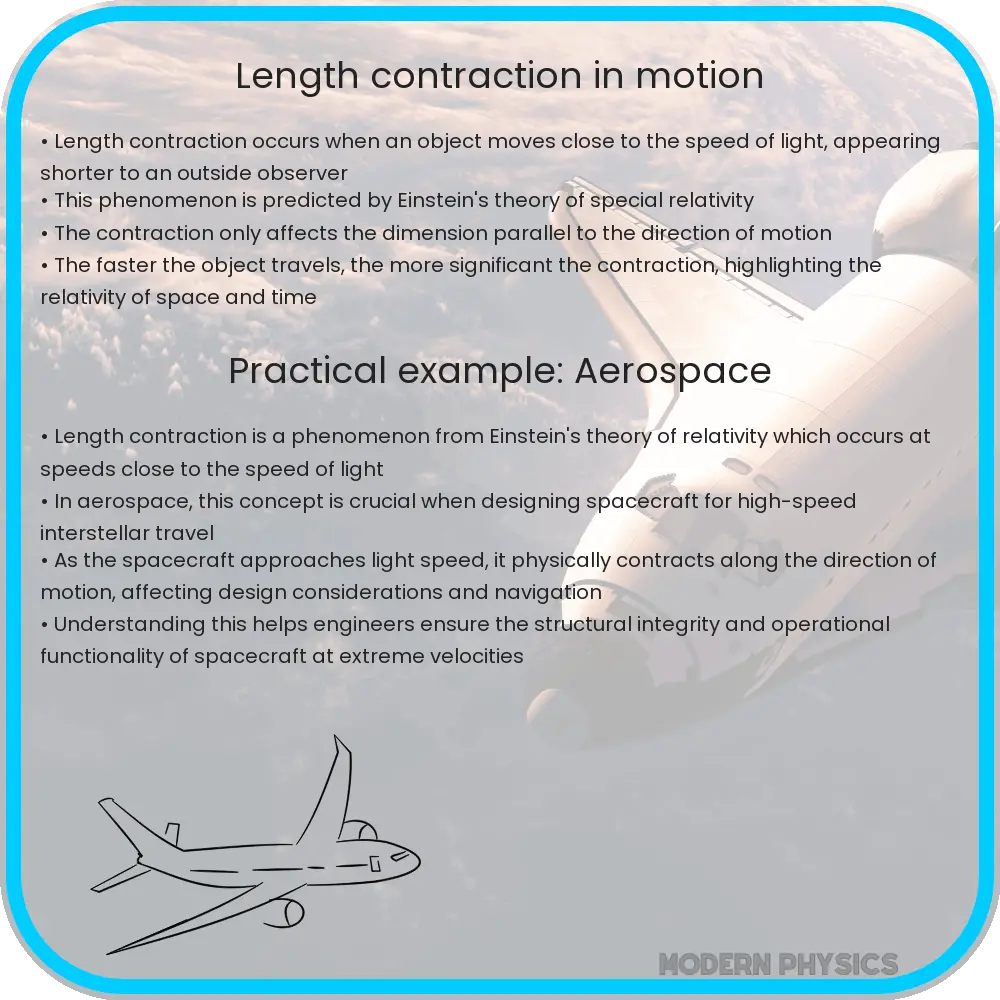Understanding Length Contraction in Motion: A phenomenon predicted by Einstein’s special relativity, where objects nearing light speed appear shorter in their motion direction.

Understanding Length Contraction in Motion
Length contraction is a fascinating and counterintuitive phenomenon predicted by Albert Einstein’s theory of special relativity. It states that objects moving at a speed close to the speed of light will appear shorter in the direction of motion when observed from a stationary reference frame. This effect is not merely an optical illusion but a real physical change resulting from the fundamental properties of space and time as described by relativity.
The Essentials of Length Contraction
Before delving into the practical implications of length contraction, it’s essential to understand its underlying principles. The phenomenon is rooted in the idea that the speed of light in a vacuum (approximately 299,792 kilometers per second) is constant and an absolute limit in the universe. This invariant speed leads to modifications in our classical views of space and time, specifically when objects move relative to each other at high speeds.
To describe length contraction mathematically, consider an object with proper length L0, which is the length measured in the frame of reference where the object is at rest. If this object moves at a velocity v relative to an observer, its length L observed in the stationary frame can be calculated using the Lorentz factor γ (gamma):
- L = L0 / γ
where γ = 1 / √(1 – v2 / c2) and c is the speed of light in vacuum. The key takeaway here is that as the velocity v approaches the speed of light, γ increases significantly, leading to a substantial reduction in the observed length L.
Effects of Length Contraction
Length contraction has several profound effects in physics and cosmology, impacting everything from space travel to the behavior of particles in accelerators. Some notable effects include:
- Space Travel: For astronauts traveling at relativistic speeds, length contraction could make distant stars and galaxies seem much closer than they appear to a stationary observer. However, the effects on human perception during such travel remain a subject of theoretical exploration.
- High-energy Particle Accelerators: In devices like the Large Hadron Collider (LHC), particles moving at speeds close to that of light experience significant length contraction. This phenomenon is crucial in calculating the interaction probabilities and dynamics within these experiments.
- Cosmological Observations: The understanding of length contraction assists astronomers in interpreting the observations of high-speed objects in distant galaxies, contributing to more accurate models of the universe’s structure and history.
Although these effects might seem esoteric, they are fundamental to the way we understand and interact with the universe at its most extreme scales. The confirmation of length contraction through experiments not only supports the theory of special relativity but also reinforces our understanding of the coherent structure of physical law.
Real-World Applications
Length contraction is not just a theoretical curiosity; it has practical applications in modern technology and science. Here are a couple of examples where understanding length contraction is crucial:
- GPS Satellites: Global Positioning System (GPS) satellites orbit the Earth at high speeds and are subject to both special and general relativistic effects, including length contraction. Precise adjustments for these effects are necessary to maintain the accuracy of GPS services used worldwide.
- Scientific Observations: When observing and measuring high-speed particles in experiments, scientists must account for length contraction to ensure their observations are accurate. This consideration is vital for experiments that involve particles traveling at relativistic speeds.
Challenges and Limitations
Despite its tested validity, the concept of length contraction remains one of the more challenging aspects of relativity to grasp and visualize. Its implications often seem strange or even paradoxical, especially when considering scenarios like the famous “twin paradox” where different observations of time and length can lead to seemingly contradictory outcomes. Understanding and explaining these effects requires a robust grasp of the basics of special relativity.
Moreover, the extreme speeds required to observe significant length contraction effects are not commonly encountered in everyday life, making direct observation and experimentation challenging. However, ongoing advancements in particle physics and astrophysics continue to provide empirical support for these relativistic effects, pushing the boundaries of what we know about the universe.
Conclusion
Length contraction, a fundamental result of Einstein’s theory of special relativity, plays a crucial role in modern physics, providing deep insights into the nature of space and time. While its effects are most noticeable at velocities close to the speed of light, understanding this phenomenon is essential for high precision technologies like GPS and cutting-edge scientific research in particle physics and cosmology. As we continue to explore the universe and develop technologies that operate at or near relativistic speeds, our understanding of length contraction will not only enhance our grasp of fundamental physics but also guide future innovations. This incredible shrinking phenomenon, once a radical idea, has become a cornerstone in the vast building of modern scientific knowledge.
